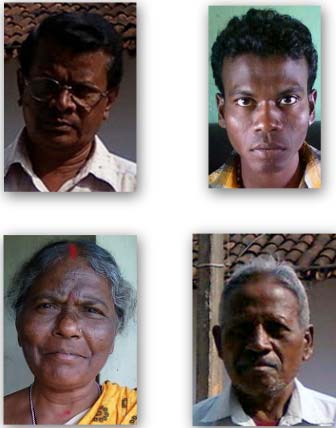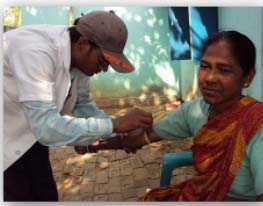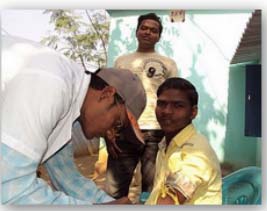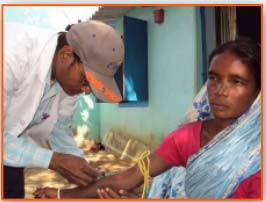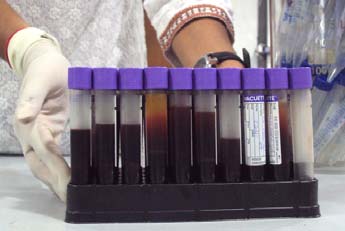CHAPTER 2
REVIEW OF LITERATURE
2.1 INTRODUCTION OF BHUMIJ TRIBE(A)
Bhumij, a non-Aryan tribe of Manbhum, Singbhum, and Western Bengal,
classed by Dalton and others, mainly on linguistic grounds, as Kolarian.
There can be no doubt that the Bhumij are closely, allied to, if not
identical with, the Mundas; but there is little to show that they ever had a distinct language of their own. In 1850 Hodgson 2 published a short
vocabulary prepared by Captain Haughton, then in political charge of
Singbhum; but most of the words in this appear to be merely Ho. The most
recent observer, 3 Herr Nottrott, of Gossner’s Mission, says that the
Bhumij resemble the Mundas most closely in speech and manners, but
gives no specimens of their language, and does not say whether it differs
sufficiently from Mundâri to be regarded as a separate dialect.
Origin:
I am inclined myself to believe that the Bhumij are nothing more than a
branch of the Mundas, who have spread to the east, mingled with the
Hindus, and thus for the most part severed their connection with the parent
tribe. This hypothesis seems on the whole to be borne out by the facts
observable at the present day. The Bhumij of Western Manbhum are
beyond doubt pure Mundas. They inhabit the tract of the country which
lies on both sides of the Subarnarakhâ river, bounded on the west by the
edge of the Chotanagpur plateau, on the east by the hill range of which
Ajodhyâ is the crowning peak, on the south by the Singbhum hills, and on
the north by the hills forming the boundary between Lohardagâ,
Hazaribagh, and Manbhum districts. This region contains an enormous
number of Mundâri graveyards, and may fairly be considered one of the
very earliest settlements of the Munda race. The present inhabitants use
the Mundâri language, call themselves Mundas, and observe all the
customs current among their brethren on the plateau of Chotanagpur
proper. Thus, like all the Kolarians, they build no temples, but worship
Buru in the form of a stone smeared with vermillion. A ecog is
invariably composed of purely jungle trees, such as sâl and others, and can therefore be ecognize with certainly as a fragment of the primeval
forest, left standing to form an abiding place for the aboriginal deities.
They observe the sarhul festival at the same time and in the same way as their kindred in Lohardagâ and Singbhum, and the lâyâ or priest is a
recognized village official. Marriages take place when both parties are of
mature age, and the betrothal of children is unknown. Like the Mundas of
the plateau, they first burn their dead and then bury the remains under
gravestones, some of which are of enormous size. On certain feast days
small supplies of food and money are placed under these big stones to
regale the dead, and are extracted early the next morning by low-caste
hindus. On the eastern side of the Ajodhya range, which forms a complete
barrier to ordinary communication, all is changed. Both the Mundâri and
the title of Munda have dropped out of use, and the aborigines of this
eastern tract call themselves Bhumij or Sardâr, and talk Bengali. The
physical characteristics of the race, however, remain the same; and
although they have adopted Hindu customs and are fast becoming Hindus,
there can be no doubt that they are the descendants of the Mundas who
first settled in the country, and were given the name of Bhumij
(autochthon) by the Hindu immigrants who found them in possession of
the soil.
Internal Structure:
The sub-tribes are numerous, and vary greatly in different districts. With
the possible exception of the iron-smelting Shelo in Manbhum, the names
of these groups seem to have reference to their supposed original
settlements. It deserves notice that the tendency to form endogamous
divisions seems to be stronger in outlying districts than it is at the
recognized head-quarters of the tribe. Thus in Manbhum and Singbhum
we find only one sub-tribe Shelo, which obviously got detached from the
parent group by reason of its members adopting, or perhaps declining to
abandon, the comparatively degraded occupation of iron-smelting. In
Midnapur, or the other hand, the Bhumij settlements are of comparatively
functional group of Shelo. The reason seems to be that when the stream of
emigration is not absolutely continuous, successive sections of immigrants
into distant parts of the country are affected in various degrees by the
novel social influences to which they are exposed. Some groups become
more rapidly hinduised than others, and thus there arise divergences of
usage in matters of food and drink, which constitute a bar to inter-
marriage, and in time lead to the formation of sub-tribes. These divisions
often outlast the differences of custom and ritual from which they took
their origin, and in some cases the prohibition of intermarriage comes to
be withdrawn, and the names alone remain to show that such a prohibition
was once on force. The exogamous divisions of the tribe are totemistic,
and closely resemble those met with among the Mundas. The rule of
exogamy is simple.
Marriage:
The aboriginal usage of adult-marriage still holds its ground among the
Bhumij, though the wealthier members of the tribe prefer to marry their
daughters as infants. The extreme view of the urgent necessity of early
marriage is unknown among them, and it is thought no shame for a man to
have a grown-up daughter unmarried in his house. The Bhumij ecognize
polygamy, and in theory at least impose no limitation on the number of
wives a man may have.
Widowmarriage: Widow‐marriage is freely permitted by the sanga
ritual. It is deemed right for a widow to marry her late husband’s younger
brother or cousin, if such an arrangement be feasible; and in the event of
her marrying an outsider, she forfeits all claim to a share in her late husband’s property and to the custody of any children she had with the
first husband
Divorce: The Bhumij of Manbhum allow divorce only when a woman has
been guilty of adultery.
Religion:
The religion of the Bhumij is flexible within certain limits, according to
the social position and territorial status of the individuals
concerned.Zamindars and well-to-do tenure-holders employ Brahmans as
their family priests, and offer sacrifices to Kali or Mahâmâyâ. The mass of the people revere the sun under the names of Sing-Bonga and Dharm, as the giver of harvests to men and the cause of all changes of seasons
affecting their agricultural fortunes. They also worship a host of minor
gods like Jâhir-Buru, Kârâkâtâ, ( Kârâ = ‘buffalo,’ and Kâtâ = ‘to cut’),
Bâghut, Kudra and Bisaychandi etc.
Occupation:
The original occupation of the Manbhum Bhumij is believed by
themselves to have been military serviceFor many years agriculture has
been the sole profession of all the sub tribes except the iron-smelting
Shelo. A few have engaged in petty trade, and some have emigrated to the
tea districts of Assam. Their relations to the land are various. The great
bulk of the Bhumij, who are simple cultivators and labourers, stand on a
far lower social level that the landholding members of the tribe.
Language:
Their language is almost identical with Mundârí is also spoken by the
Bhumij tribe of Singbhum and neighbourhood. Santhâlí language is
spoken in the west of the district. In Manbhum they are found in the west,
and, according to Mr. Risley, speak Mundârí language. The Bhumij on the
eastern side of the Ajodhya range speak Bengali. The Tamariâs are a sub-
tribe of the Bhumij, who were originally settled in Pargana Tamar of
Ranchi. Their dialect does not differ from that of the Bhumij proper.
Other Tamariâs speak a dialect of Magahí.(6)
List of People who contributed in blood sample for research :
NAME VILLAGE
1)
BHUJANG PRASAD SINGH [M] - CHOLAGORA
2)
MANOJ SARDAR [M] - TILKAGARH
3)
KANDI BHUMIJ [F] - GHAGIDIH
4)
SUNDARI BHUMIJ [F] - GHAGIDIH
5)
GURVA BHUMIJ [M] - GHAGIDIH
6)
PURENDAR BHUMIJ [M] - GHAGIDIH
7)
PARSURAM SARDAR [M] - GHAGIDIH
8)
GITA SARDAR [F] - GHAGIDIH
9)
Mr. SARDAR [M] - GHAGIDIH
10)
SUKLAL SARDAR [M] - GHAGIDIH
11)
KUNI SARDAR [M] - GHAGIDIH
12)
MEENA SARDAR [F] - GHAGIDIH
13)
RUP SINGH [M] - DOMJURI
14)
ARUN SINGH [M] - DOMJURI
15)
SRIKANT SINGH [M] - DOMJURI
16)
SOHAN SINGH [M] - DOMJURI
17)
GULAB SINGH [M] - DOMJURI
18)
INDRA SINGH [M] - DOMJURI
19)
DEVA SINGH [M] - DOMJURI
20)
MOHAN SINGH [M] - DOMJURI
21)
PADMAWATI SINGH[F] - DOMJURI
22)
LAKHAN SINGH [M] – DOMJURI
23)
SRIKANT SARDAR [M] – GOMIASAI
24)
NARAYAN SARDAR [M] – KITADIH
25)
KANHAI SARDAR [M] – GOMIASAL
26)
BIRBAL SARDAR [M] – BHELAIDIH
27)
ARUN SARDAR [M] – VELAIDIH
28)
SRIKANT SARDAR [M] – VELAIDIH
29)
MANGAL SINGH HANSDA [M] – JONRAGARA
30)
DHURMU SARDAR [M] – TILKAGARH
31)
BHUDRAI SARDAR [M] – TILKAGARH
32)
RUPCHAND SARDAR [M] – TILKAGARH
33)
Mrs. HULSAI SARDAR [F] – TILKAGARH
34)
NARDE SARDAR [M] – TILKAGARH
35)
SUDARSAN SARDAR [M] – TILKAGARH
36)
Mr. GUNADHAR SARDAR [M] – GITILATA
37)
SHEFALI SINGH [F] – GITILATA
38)
SATRUGHON SARDAR [M] – TETLA
39)
HARISHCHANDRA SINGH [M] – CHANDPUR
40)
KAMALANI SINGH [F] - TIRILDIH
41)
ARJUN SINGH [M] – GITILATA
42)
SUDARSAN BHUMIJ [M] – BALIDIH
43)
GANESH SINGH [M] – GITILATA
44)
NARAYAN SINGH [M] – GITILATA
45)
RATAN SARDAR [M] – TIRILDIH
46)
H. SARDAR [M] – TIRILDIH
47)
MOSO SARDAR [M] – CHIRING
48)
BHAWARI SARDAR [M] – TILKAGARH
49)
HARISHCHANDRA SINGH [M] – GITILATA
50)
DHIRENDAR [M] – KUDADA
51)
SURAJ PRABHASH SINGH [M] – KHADADERA
52)
AJIT SINGH [M] – TIRILDIH
53)
BALRAM SARDAR [M] – TUDI
54)
BASANTI SARDAR [F] – BADEDIH
55)
SOBINAY SINGH [M] – TIRILDIH
56)
R.SINGH [M] – TIRILDIH
57)
RAMKADA SARDAR [M] – BALIDIH
58)
NIRMAL SARDAR [M] – DEGPA
59)
LAKHI RAM HANSDA [M] – SANKARPUR
60)
ARUN SARDAR [M] – DEGAM
61)
TUNU SINGH [M] – HATNABEDA
62)
MADHUSUDAN SINGH [M] – HATNABERA
63)
LAKHAN SINGH [M] – CHANDPUR
64)
BELBATI SINGH [F] – CHARGIRA
65)
RAGHU BHUMIJ [M] – GHAGIDIH
66)
NAND SINGH [M] – CHAIDIH
67)
Mr. GURUCHARAN [M] – KHADADERA
68)
BABLU SARDAR [M] – KAWALI
69)
Miss. SABITA SARDAR [F] – PAURU
70)
Miss. KUNI SARDAR [F] – RANIDIH
71)
BALARAM SARDAR [M] – TIRILDIH
72)
Mr. ASIT SARDAR [M] – PICHALI
73)
Mr. GUNADHAR BHUMIJ [M] – CHAIGARA
74)
Mrs. ANJALI SINGH [F] – GUTKA
75)
Mr. BADAL SARDAR [M] – BAHARDARI
76)
Mr. VIDYADHAR SINGH [M] – BHUNTKA
77)
SANTOSH SINGH [M] – CHANDPUR
78)
UTAM KUMAR SINGH [M] – PICHALI
79)
KARTIK SARDAR [M] – BHURIDIH
80)
BHIRANJAN SARDAR [M] – BALIDIH
81)
MIRJA SARDAR [M] – BALIDIH
82)
JANTA SADAR [M] – BAHARDADIH
83)
PUSHPLATA SINGH[M] – GITILATA
84)
DARA SINGH [M] – TIRILDIH
85)
Miss. BASANTI SARDAR [F] -- PAURU
86)
VIJAY SARDAR [M] – KARANDIH
87)
LALA SINGH [M] – BAHARDADIH
88)
SITARAM BHUMIJ [M] – CHAIGARA
89)
BISHEKHAR SARDAR [M] – PICHALI
90)
KARTIK SARDAR [M] – JANUMDIH
91)
SHASHI CHARAN SINGH [M] – PICHALI
92)
NANDLAL BHUMIJ [M] – CHANGIRA
93)
Miss. SUMITRA SINGH [F] – TIRILDIH
94)
JANVI SINGH [F] – TIRILDIH
95)
AJAY SINGH [M] – RAJABDSH
96)
RAJU SINGH [M] – HATNADERA
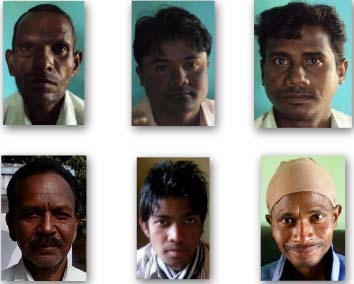


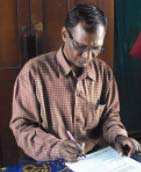
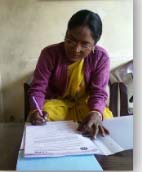



97)
Mr. AMULYA SARDAR [M] – KUDRUKOCHA
98)
Mr. SUBODH SARDAR [M] – JHARIA
99)
Mr. RAJMOHAN [M] – SARDAR
100) Mr. NIRANJAN SINGH [M] – TIRILDIH
Fig 8: People who contributed:
